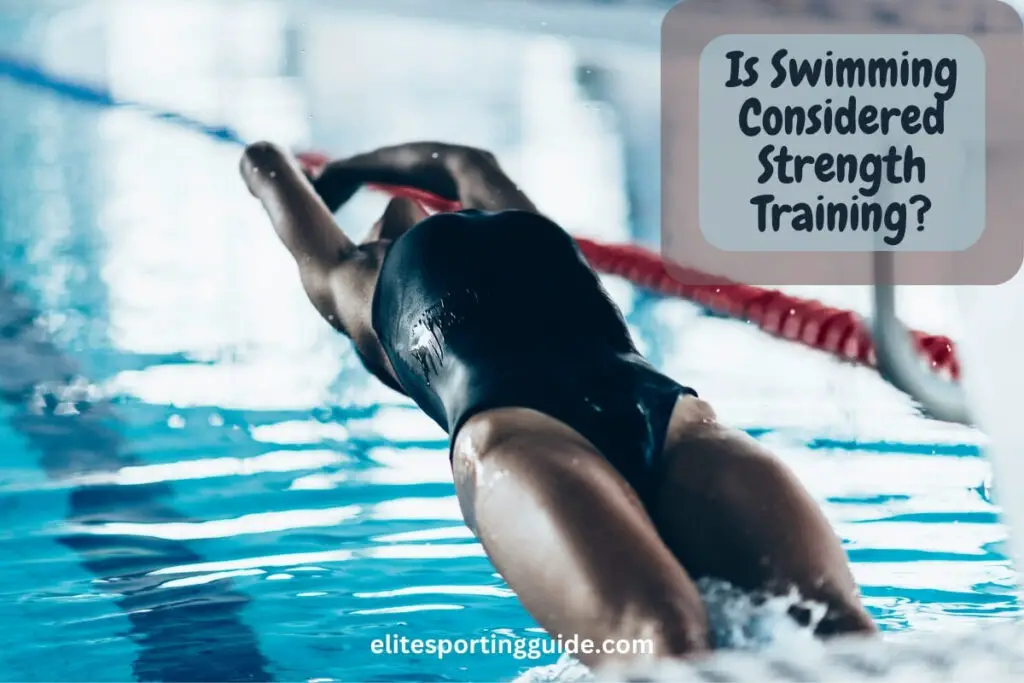While swimming is often associated with cardiovascular benefits and endurance, its role in strength development might be less apparent.
In this article, we’ll search through the unique aspects of swimming as a form of exercise and investigate its potential as a strength-building activity.
Touring the dynamics of resistance in water and the muscle engagement required for various strokes, we’ll find out how swimming contributes to muscular strength, endurance, and overall fitness.
Is Swimming Considered Strength Training?
Yes, swimming can be considered a form of strength training. It engages multiple muscle groups, promotes endurance, and improves overall strength by working against water resistance. Regular swimming sessions can lead to noticeable gains in muscular strength and tone, making it an effective component of any strength training regimen.
Introduction to Swimming and Strength Training
Combining swimming and strength training can provide a well-rounded fitness routine that offers a wide range of benefits. Here’s an introduction to both activities and how they can complement each other:
1. Swimming:
• Cardiovascular Endurance: Swimming is an excellent cardiovascular exercise that engages the entire body. It improves heart health, lung capacity, and overall endurance.
• Low Impact: Swimming is low-impact, making it suitable for people of all ages and fitness levels. It’s gentle on the joints while still providing a highly effective workout.
• Muscle Engagement: Swimming works almost all the major muscle groups in the body, including the arms, legs, core, back, and shoulders. It helps tone and strengthen muscles without putting stress on the joints.
• Flexibility and Range of Motion: The fluid movements involved in swimming help improve flexibility and range of motion in the joints, promoting better overall mobility.
• Mental Well-being: Many people find swimming to be a relaxing and meditative activity. It can help reduce stress, improve mood, and promote mental clarity.
2. Strength Training:
• Muscle Strength and Tone: Strength training involves resistance exercises that challenge the muscles, leading to increased strength, endurance, and muscle tone.
• Bone Health: Strength training is beneficial for bone health and can help reduce the risk of osteoporosis by increasing bone density.
• Metabolism Boost: Building lean muscle mass through strength training can boost metabolism, leading to improved calorie burning and weight management.
• Injury Prevention: Strengthening the muscles around the joints can help prevent injuries and improve overall stability and balance.
• Functional Fitness: Many strength training exercises mimic real-life movements, improving functional fitness and making everyday tasks easier to perform.
3. Combining Swimming and Strength Training:
• Comprehensive Fitness: Swimming and strength training target different aspects of fitness, including cardiovascular health, muscular strength, endurance, and flexibility.
Combining both activities ensures a comprehensive workout routine that promotes overall fitness.
• Cross-Training Benefits: Swimming can serve as an excellent form of cross-training for strength training and vice versa.
Each activity challenges the body in unique ways, preventing overuse injuries and promoting balanced muscle development.
• Varied Workouts: Alternating between swimming and strength training sessions adds variety to your workouts, keeping them interesting and engaging over time.
• Recovery and Active Rest: Swimming can be used as a form of active recovery on days when you’re not strength training.
The low-impact nature of swimming can help reduce muscle soreness and promote faster recovery between strength training sessions.
• Customization: You can tailor your swimming and strength training routine to suit your specific fitness goals, whether it’s building muscle, improving cardiovascular endurance, or enhancing overall health and well-being.
Incorporating both swimming and strength training into your fitness regimen can lead to a balanced and effective workout routine that promotes optimal health and fitness.
Analyzing Swimming as a Physical Activity
Analyzing swimming as a physical activity unveils its multifaceted benefits and unique characteristics.
As a low-impact exercise, swimming offers individuals of all ages and fitness levels an opportunity to engage in a full-body workout that promotes cardiovascular health, muscular strength, and endurance.
Its resistance-based nature, facilitated by the density of water, challenges multiple muscle groups simultaneously, fostering muscle development and toning.
Moreover, swimming enhances flexibility, improves joint mobility, and contributes to mental well-being through its meditative and stress-relieving qualities.
Beyond its physical attributes, swimming serves as a social and recreational outlet, fostering community engagement and promoting an active lifestyle.
Key Components of Strength Training

Benefits of Swimming for Strength Development
Swimming is an exceptional activity for strength development due to its unique combination of resistance training and full-body engagement.
As individuals push and pull against the water’s resistance, virtually all major muscle groups, including the arms, shoulders, back, core, and legs, are activated.
This comprehensive engagement fosters muscle growth, endurance, and overall strength.
Additionally, swimming offers a low-impact environment, making it accessible to people of all ages and fitness levels while minimizing the risk of joint strain or injury
Furthermore, the rhythmic nature of swimming promotes cardiovascular health and mental well-being, fostering a holistic approach to strength development that not only builds physical strength but also enhances overall fitness and wellness.
Post you may be interested in: Can Swimming Be Bad For Your Back?
Muscle Groups Engaged in Swimming

Swimming engages a wide array of muscle groups throughout the body, making it an excellent full-body workout. Here’s an overview of the main muscle groups involved in swimming:
1. Upper Body Muscles:
• Deltoids: These shoulder muscles are heavily engaged during the pulling phase of strokes like freestyle, backstroke, and butterfly.
• Latissimus Dorsi: Located in the back, the lats play a major role in pulling and propelling the body through the water.
• Pectoral Muscles (Pecs): The chest muscles contribute to the arm movements in strokes like freestyle and breaststroke.
• Trapezius: The traps help stabilize the shoulders and support the arm movements during swimming.
2. Core Muscles:
• Abdominals: The core muscles, including the rectus abdominis, obliques, and transverse abdominis, provide stability and help maintain proper body position in the water.
• Erector Spinae: These muscles, located along the spine, assist in maintaining proper spinal alignment and stability during swimming.
3. Lower Body Muscles:
• Quadriceps: The quads are engaged during kicking movements in strokes like freestyle, backstroke, and butterfly.
• Hamstrings: These muscles are involved in the kicking motion and help propel the body forward in the water.
• Gluteal Muscles (Glutes): The glutes contribute to the power and propulsion generated during the kicking phase of swimming strokes.
• Calves: The calf muscles assist in the kicking action, especially in strokes like freestyle and butterfly.
4. Additional Muscles:
• Forearm Muscles: Muscles in the forearms are heavily engaged during the pulling motion in strokes like freestyle and butterfly.
• Hip Flexors: These muscles help maintain hip position and assist in kicking movements during swimming.
• Triceps: Located in the back of the upper arm, the triceps provide additional strength during the pushing phase of strokes like freestyle and backstroke.
Overall, swimming provides a comprehensive workout that targets virtually all major muscle groups in the body. The combination of upper and lower body movements, along with core stabilization, makes it an effective exercise for building strength, endurance, and overall fitness.
Swimming Techniques and Strength Building
Here’s a list of swimming techniques and how they contribute to strength building:
1. Freestyle (Front Crawl):
• Engages the shoulders, arms (deltoids, triceps, biceps), and upper back (latissimus dorsi) during the pulling motion.
• Strengthens the core muscles as they stabilize the body and facilitate rotation.
• Improves leg strength through the flutter kick, engaging the quadriceps, hamstrings, and glutes.
2. Backstroke:
• Targets the back muscles (trapezius, rhomboids, latissimus dorsi) during the pulling motion.
• Engages the arms (deltoids, triceps, biceps) and promotes shoulder stability.
• Develops leg strength and coordination with the flutter kick, activating the quadriceps, hamstrings, and glutes.
3. Breaststroke:
• Strengthens the chest muscles (pectorals) and shoulders during the arm pull.
• Engages the core muscles, including the abdominals and lower back, to stabilize the body and facilitate the undulating motion.
• Builds leg strength through the simultaneous whip kick, which targets the quadriceps, adductors, and hip flexors.
4. Butterfly:
• Requires significant upper body strength, engaging the chest, shoulders, arms (deltoids, triceps, biceps), and upper back (latissimus dorsi) during the powerful arm stroke.
• Challenges the core muscles, including the abdominals and lower back, to maintain body position and stability.
• Develops leg strength and coordination with the dolphin kick, activating the quadriceps, hamstrings, and glutes.
Overall, each swimming technique provides a full-body workout that targets different muscle groups, promotes muscular endurance, and contributes to overall strength development.
Incorporating a variety of swimming strokes into a training regimen can help individuals achieve balanced muscle development and improve overall fitness.
Post you may like: Is Swimming Cardio?
Swimming’s Role in Strength Development
In conclusion, swimming undeniably plays a significant role in strength development.
Despite being primarily recognized for its cardiovascular benefits, swimming offers a comprehensive full-body workout that engages various muscle groups against water resistance.
Its low-impact nature makes it accessible to individuals of all ages and fitness levels, while its ability to improve muscle endurance and tone underscores its efficacy as a form of strength training.
Incorporating swimming into a well-rounded fitness routine not only enhances muscular strength but also fosters overall health and well-being, making it a valuable addition to any fitness regimen.



